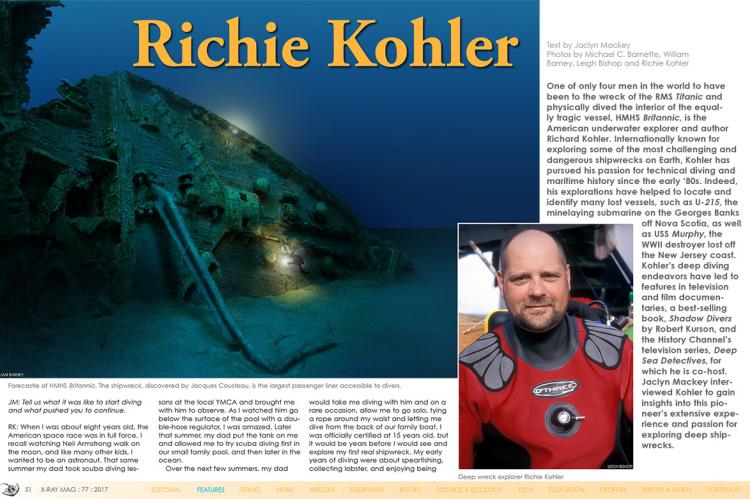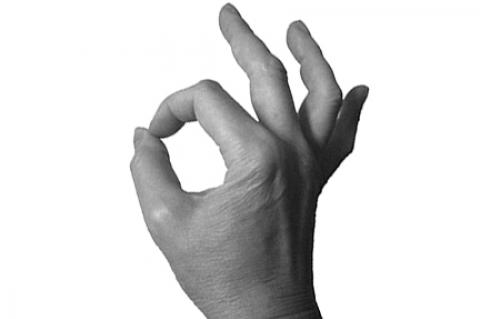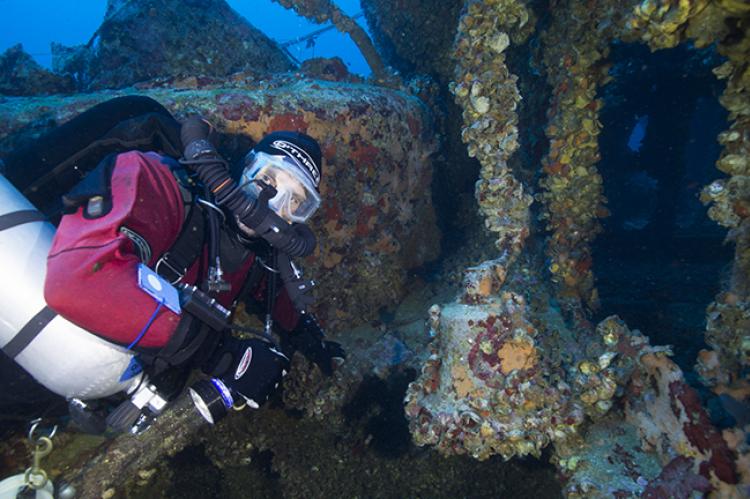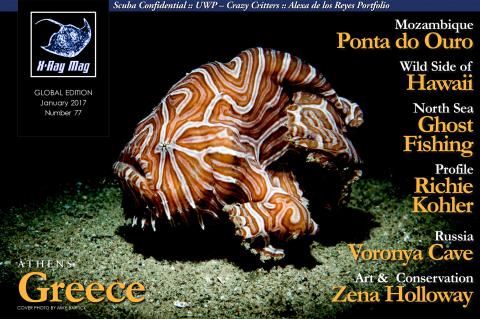Interview with Richie Kohler
One of only four men in the world to have been to the wreck of the RMS Titanic and physically dived the interior of the equally tragic vessel, HMHS Britannic, is the American underwater explorer and author Richard Kohler. Internationally known for exploring some of the most challenging and dangerous shipwrecks on Earth, Kohler has pursued his passion for technical diving and maritime history since the early ‘80s.
Indeed, his explorations have helped to locate and identify many lost vessels, such as U-215, the minelaying submarine on the Georges Banks off Nova Scotia, as well as USS Murphy, the WWII destroyer lost off the New Jersey coast. Kohler’s deep diving endeavors have led to features in television and film documentaries, a best-selling book, Shadow Divers by Robert Kurson, and the History Channel’s television series, Deep Sea Detectives, for which he is co-host. Jaclyn Mackey interviewed Kohler to gain insights into this pioneer’s extensive experience and passion for exploring deep shipwrecks.
Tags & Taxonomy
JM: Tell us what it was like to start diving and what pushed you to continue.
RK: When I was about eight years old, the American space race was in full swing. I recall watching Neil Armstrong walk on the moon, and like many other kids, I wanted to be an astronaut. That same summer, my dad took scuba diving lessons at the local YMCA and brought me with him to observe. As I watched him go below the surface of the pool with a double-hose regulator, I was amazed. Later that summer, my dad put the tank on me and allowed me to try scuba diving first in our small family pool, and then later in the ocean.
Over the next few summers, my dad would take me diving with him and on a rare occasion, allow me to go solo, tying a rope around my waist and letting me dive from the back of our family boat. I was officially certified at 15 years old, but it would be years before I would see and explore my first real shipwreck. My early years of diving were about spearfishing, collecting lobster and enjoying being underwater. Now, it is almost 40 years later, and I am still as enthusiastic and excited about the next dive I am about to do as I was when I was eight years old. It does not really matter to me if it is a 400ft (122m) shipwreck exploration, a 100ft (33m) lobster dive, or a winter bottle dive in the local rivers and bays. I love it all, and I am happy when thinking about or planning for a dive!
JM: How long have you been diving and how has your diving evolved? Touch on some technical aspects about equipment and gas.
RK: Next year will be 40 years that I have been a certified scuba diver, and in that time, I have seen incredible leaps and bounds in the sport I have grown to identify with so much. I was originally trained on both the double-hose regulator and the then new-fangled single-hose regulator. This was at a time when having a submersible pressure gauge was an option, and there was no such thing as a BCD or dive computer.
As the years went on and I went farther offshore and deeper in pursuit of shipwrecks, my equipment changed. Moving into the deeper, colder waters of the North Atlantic, I quickly changed my wetsuit for a drysuit so I could be more comfortable and spend a longer time in the water. When the aluminum 80 cylinders came into vogue, I quickly changed from the steel 72 because getting eight extra cubic feet of air is always a good thing! Soon, I banded them together and was diving with double aluminum 80s.
The introduction of steel 120 tanks once again had me changing to add even more air on my back, for longer and deeper dives. If you look at it linearly, it was 72-80-160-240 cubic feet of gas on my back over a 25-year period, but even that eventually would give way to the current equipment, the closed-circuit rebreather. Of course, using air changed to nitrox in the late ‘80s, trimix for even deeper diving in the ‘90s, and with the turn of the century and the use of my rebreather, I often use heliox for deep dives. I can only imagine where we will be in another 10 years!
JM: Who were the guys you respect? Who inspired you?
RK: When I was 15, I became a junior scuba diver and the following year a basic (adult) scuba diver. My instructor in Florida was Paul Heinerth, a then young maverick cave diver who would go on to garner a name for himself in cave exploration and technical diving. I am sure I made him a little gray in those classes.
A decade later, I was learning to dive wrecks in the New York area but there was no official training or classes. Knowledge and know-how was passed from the older, more experienced divers and dive boat captains down to the “greenhorns,” if you were lucky and social within a group. When there was an accident or an issue, it was discussed and dissected among our group, and lessons were sometimes tragically learned. Equipment was adapted and sometimes customized for the diving we were doing, which at the time was way beyond the accepted norms for sport diving.
Decompression dives and air dives to depths over 200ft (61m) earned us the nickname the “Crazies” and “Thugs,” but as a group we came up with the more respectable name for our gang—The Atlantic Wreck Divers. Almost everyone in the group was much older and more experienced than me, and they took me under their wing, helping me choose the right gear and teaching techniques and philosophies that would help keep me out of trouble and hopefully alive. Through the years, I have had many other incredibly talented and experienced instructors help me along, from mixed gasses and onto numerous rebreather certifications, and every one of them are a part of the diver I have become.
JM: You've had a public life in TV, film and books. Explain how that came about.
RK: Until 1990, I had been like most folks, working a job during the week, and diving for fun on the weekends and holidays. Up until 1990, diving the Andrea Doria was the highlight of my diving experience, and almost every summer I would book every trip I could afford to get back out to the Mount Everest of shipwrecks. All that changed with a virgin shipwreck, one that no government, historian or expert could explain.
The work to identify the submarine was very deep and the diving dangerous. It would tragically take the lives of three of my friends and change my life. That story is well documented in the New York Times bestselling book "Shadow Divers" by Robert Kurson, and I always thought this was the end of the story. But fate had another plan for me. After the airing of an Emmy-award winning documentary, "Hitler’s Lost Sub", a NOVA film detailing the exploration of the submarine, my diving partner John Chatterton and I received a phone call from the executives at A&E television in New York City. They had seen the documentary (and us) and wanted us to work for them on a new television series about diving and underwater mysteries.
We had never acted or been on television before and were stunned, but somehow the program "Deep Sea Detectives" was a success for the History Channel with six seasons (56 episodes). This, of course, provided numerous other documentary projects around the world, the most famous being our self-funded expedition to Titanic in 2005 and subsequent 2006 expedition to Titanic’s sister ship Britannic. This would lead to another book, "Titanic’s Last Secrets" by Brad Matsen, and lit the passion for me to spend the next 10 years of my life trying to solve the mystery of Britannic.
Along the way there were many other films and projects on lost American submarines, destroyers and U-boats. Probably the most special for me was working alongside famed underwater explorer Dr Bob Ballard, which culminated in correcting fractured history and allowing a WWII sea captain to receive his due honor (posthumously) in an award ceremony at the US Pentagon. This was one of my prouder accomplishments as a shipwreck explorer.
JM: Discuss your involvement with Titanic, Britannic, U-Boat Malta, the challenges you faced, the triumphs, etc.
RK: In 2005, we documented new evidence and parts of Titanic’s hull that changed the way some experts saw the break-up and sinking of the ship. It centered around an engineering feature called an expansion joint.
The theory was that these joints were flawed and may have caused Titanic to break up during the flooding, in effect causing it to sink sooner and faster. In order to see to test these theories, we needed to go to Titanic’s sister ship, the HMHS Britannic (which had sunk off a Greek Island under mysterious circumstances during WWI) to make comparisons between the two ships. This Britannic expedition was planned for 2006 and would really have an effect on me.
When exploring Titanic, you are crammed into a submersible, the entire project a huge and expensive undertaking to dive 2.5 miles (4,023m) down to the bottom of the Atlantic. Once on the bottom, the water is freezing and the seafloor lifeless, much like a moonscape. The wreck is twisted and broken, and the fact this is a mass grave for 1,500 people is never far from you. On the other hand, Britannic is relatively shallow and at 400ft (122m) can be visited by divers. The water there is warm, blue and very clear. The wreck is encased in colorful sponges and marine growth while shoals of fish at times block the visibility. Where Titanic is cold, dead and broken, Britannic is alive and very much intact.
If it was just for the visual, it’s easy to understand why a diver for Britannic would hold such allure, but there were many unanswered questions and a mystery to be solved here as well. What caused her to sink and why did she sink so fast? I once again found myself obsessed with another shipwreck mystery, one that would take a decade of my life to solve, and the tragic cost of one of my friends' life. It’s not only that diving to 400ft (122m) is an incredibly challenging technical dive, but logistically the wreck is difficult to access due to its remote location. At times, the bureaucracy protecting the wreck can be as daunting as the dive itself. It would require a team approach over a decade of expeditions to finally solve the mystery of the Britannic.
JM: Explain the "Science Fiction is Science Fact” theme.
RK: In 2015, I met the members of the U-Group aboard their amazing research vessel the U-boat Navigator. Partnered with the Russian Geographical Society, the 30m vessel had two submersibles (a three-person Triton and a one-man prototype Triton); a Perseo ROV; a six-person hyberbaric chamber and a diving bell. The U-group had been filming Britannic for a feature-length film and we agreed to work together on our planned 2015 and 2016 expeditions.
In working with submersibles, ROVs and the diving bell at depth, it was clear to all involved this seemed like a scene from the science fiction movie, The Abyss. Using scooters, our dive team circumnavigated the largest passenger shipwreck in the world, while filming the wreck and being escorted and watched over by some of the most advanced underwater equipment available. Upon surfacing from a dive, director of photography Evan Kovacs commented that our dive “seemed like something from science fiction”, to which I answered, “No, Evan, it’s science fact!”
Of all the equipment aboard the Navigator, the most basic was the diving bell, an underwater elevator or lift, with a clear acrylic dry bell that divers could stand up in and be out of the water. The bell provided a safe habitat with real-time communications and video feed, as well as extra breathing gas in case of an emergency. Although low-tech compared to the submersibles and the ROV, the diving bell was a vital tool for the diving component of the project, made the dives safer, and the long six-hour decompression phase safer.
JM: What does exploration signify to you? Why is this your passion?
RK: I have been drawn to the darkness of caves, shipwrecks and deep water for as long as I can remember. Like the thrill I get from riding a motorcycle or downhill skiing, it is hardwired into who I am as a person. At heart, I am an adrenalin junkie. But there is a cerebral side to the rush of adventure I get from diving. For me, that is not only the technical aspect of gasses and buttons and shiny chrome gadgets, but the stories and unanswered questions, the research and the historical documents that complete the package of exploration.
I am a nerd at the core who wants to be part Indiana Jones and part Neil Armstrong. It is not so strange when I consider that in school, both science and history were my favorite subjects. In the early years, researching shipwrecks came easily when motivated by finding artifacts or virgin wrecks. It became harder when the work spanned years of effort, like on the mystery U-boat off New Jersey or even the past decade of work on HMHS Britannic. It’s easy to become distracted and give up, going after easier goals. To stay the course, I have always focused on the human aspect of a shipwreck. It becomes personal and sharpens the focus of the “why.”
For me, the human connections will always be the most poignant and the real reward is when what we do as divers can make a real difference in someone’s life. ■
For more information about Richard Kohler and his book, "Mystery of the Last Olympian", go to: www.bestpub.com.
Download the full article ⬇︎































